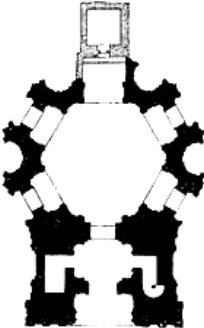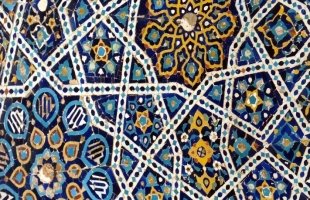The article throws the light on the information about the bright example of Middle Asian architectural school — the mausoleum of Turabek-Khamum in the town of Kuhna Urgench.
Key words: Turabek-Khamum, the mausoleum, Middle Asia, the Timurids, architecture, Kuhna Urgench, domn, majolica.
Статья освещает информацию о ярком примере среднеазиатской архитектурной школы XIV-XV вв. — мавзолее Турабек- Ханум в городе Кухна Ургенч.
Ключевые слова: Турабек-Ханум, мавзолей, Средняя Азия, архитектура, Темуриды, Кухна Ургенч, купол, майолика.
XIV-XV cc. in architecture of Central Asia are marked by rise of creative thought of architects of Central Asia as result of fruitful interference of the Central Asian architectural and art schools and arts of Iran, Azerbaijan and Afghanistan. All this became possible thanks to Amir Temur, his passions to innovation and development of science, culture and a technical thought, its tradition to bring the best masters from the areas won by him. On a large scale construction of large and structurally complex ensembles which became expression and the proof of greatness of all dynasty Temuridov to this day was developed in the capitals of the state of Amir Temur under his management.
During this period of blossoming, «Temuridsky Kuatrochento» (Temuridsky the Renaissance [1.28]) as the most important architectural centers of the cities served technically difficult on execution for those times complexes of memorial, religious and public buildings and their ensembles. − all this led achievements of architects, artists on ornaments on ceramic tiles and woodcarving to synthesis and regeneration of the settled centuries-old Central Asian traditions, having led to the birth of powerful architectural school.
One of bright innovations of Temurids' architectural and art school, besides outstanding achievements of landscape gardening art introduction of color to a decor of architectural volumes served: color majolica ornaments in interiors and exteriors of buildings. For example, for comparison in XII c. turquoise tiles could be observed on walls only of certain buildings as certain colorful spots on a monochrome cloth of a bricklaying. Thanks to comprehensive effective interactions of the state of Amir Temur to the won Iran there was a fruitful interference of cultures, arts, architecture and applied art. 14th century architects borrowed a technique of a decor of facades of the Iranian architectural school: the multi-color bright pattern to become the business card in a decor of exteriors of interiors of memorial and religious buildings now and Central Asia. At all variety of forms of the Central Asian architectural ornament to it the strict logicality, mathematically calculation and a geometrical component of each scheme of an ornament are characteristic. It should be noted that in a decor of monumental architecture, there is a special system in an arrangement of patterns which is designed to provide «a perception threshold», i.e. the integrity of composition of an ornament was published, large color accents of the big planes of walls, drums, domes, emphasizing the main subject of composition. And also what is not unimportant to disclose close richness of the hidden symbolical sense of each ornament on poles, arches of portals and in interiors of buildings. Thus, each ornamental composition, being a part of the difficult general, at the same time in itself represents the finished art musterpiece.
The ceramic mosaic for the first time found application in the mausoleum Turabek-Hanum in Kukhna-Urgench which is one of early monuments of the Central Asian architecture. Outside on building walls color panels are contritely allocated against the background of a laying from polished unglazed bricks (See Fig. 1) «The outline of the plan is developed thinly and gracefully: entrances — apertures alternate with beautifully pro-thinned out deep pentagonal niches.

Fig. 1. Plan of the Mausoleum Turaber-Hanum in Kukhna-Urgench XIV-XV cc.
In architecture vertical lines are underlined: portal, niches on external sides of a rotunda, decorative panels on a drum have the proportions extended up». [2.55] But indelible makes impressions on the viewer of a mosaic of an interior: wall majolica ornaments in blue-violet scale, a difficult pattern of a dome, as if the azure sky with millions of shining stars.
At the beginning, covered with color glaze an external surface of a brick or a tile, a terracotta tile. In a coloring prevailed turquoise, blue and blue tone. The decor was limited to flower motives, lines from the Koran. Further in an architectural decor painted glazed tiles appeared. The world fame from experts and judges of east decor was gained by the Kashan pattern (tiles with thin highly decorative pattern) which extended to some areas of the southern Turkmenistan.
The equipment of a ceramic carved mosaic consists in previously cut out (thickness sometimes only in several millimeters) of glazed ceramic tiles of the elements of future pattern, different in color, connected together in composition unsurpassed on the accuracy and beauty of an ornament. The prepared pattern was mounted and fastened to a wall plaster. The complexity, jewelry accuracy of this equipment is also that color of glaze of a ceramic mosaic was distinguished by purity of tone, brightness and intensity that was difficult to achieve when roasting painted tiles: separate paints spread and mixed up (See Fig. 2)
At all complexity of execution of a geometrical decor the pattern of a dome is perceived as harmoniously complete image, a number of the arch niches which are serially replaced by mosaic panels gives an impression of weightlessness of this huge dome. The technique of registration of an interior of the mausoleum consists in increase of decorative effect from below up, reaching in a pattern of a dome of the greatest of color concentration.

Fig. 2. Mausoleum Turabek-Hanum. Interior. Majolica. Domn décor
Distinctive feature of the mausoleum Turabek-Hanum from portal and dome mausoleums of the previous period, is the fact that the main attention of builders was concentrated on decoration of portals, the building of this mausoleum is solved as composition from several harmoniously connected architectural volumes. The main volume of the mausoleum represents absolutely "... the dodecahedral rotunda, unusual to Central Asia, topped with a drum with a high conic blue dome. From the South adjoins harmonious proportions of portal, from the North — a dome tomb. In the plan the correct hexagon of the main room with the entrances located from each party is skillfully entered in a dodecahedron of an external contour» [4].
Thus being the most striking example of the Central Asian architectural school XIV-XV cc. the mausoleum Turabek-Hanum blows the mind of the visitor, giving rise to a sublime poetic image in consciousness of creatively conceiving person. Even more the beautiful legend of the beauty Turabek-Hanum, but that's another story impresses...
References:
- Пугаченкова Г. А., Зодчество Центральной Азии. // Изд: Гафур Гуляма. Т., 1976.
- Ибн Арабшах. Темур тариҳида тақдир ажойиботлар 2к. — Т.: 1993.
- Булатов М. С. Мавзолеи Самарканда — жемчужина архитектуры Средней Азии.// Изд.: Гафур Гуляма.‒ 1976.
- www.advantour.com/rus/turkmenistan/dashoguz/tyurabek-khanym.htm https://www.google.com/url?sa=i&rct=j&q=&esrc=s&source=images&cd=&cad=rja&uact=8&ved=2ahUKEwjh083Wyf7bAhUSb5oKHc-oDZIQjRx6BAgBEAU&url=https %3A %2F %2Fwww.advantour.com %2Frus %2Fturkmenistan %2Fdashoguz %2Ftyurabek-khanym.htm&psig=AOvVaw27qqv-VvNFsfuTlCmOPIOk&ust=1530557638758561







